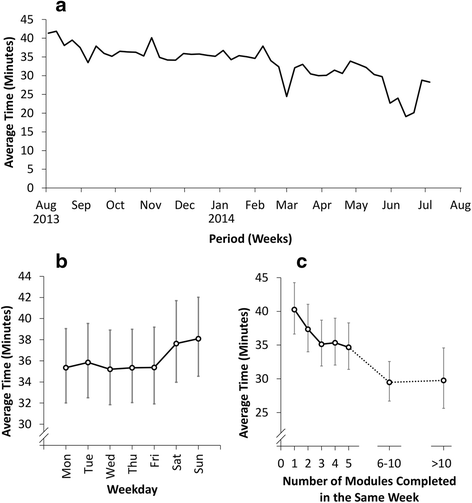An evaluation of UK foundation trainee doctors' learning behaviours in a technology-enhanced learning environment
- PMID: 27142695
- PMCID: PMC4855751
- DOI: 10.1186/s12909-016-0651-z
An evaluation of UK foundation trainee doctors' learning behaviours in a technology-enhanced learning environment
Abstract
Background: Technology-Enhanced Learning (TEL) can be used to educate Foundation Programme trainee (F1 and F2) doctors. Despite the advantages of TEL, learning behaviours may be exhibited that are not desired by system developers or educators. The aim of this evaluation was to investigate how learner behaviours (e.g. time spent on task) were affected by temporal (e.g. time of year), module (e.g. word count), and individual (e.g. knowledge) factors for 16 mandatory TEL modules related to prescribing and therapeutics.
Methods: Data were extracted from the SCRIPT e-Learning platform for first year Foundation trainee (F1) doctors in the Health Education England's West Midland region from 1(st) August 2013 to 5(th) August 2014. Generalised Estimating Equation models were used to examine the relationship between time taken to complete modules, date modules were completed, pre- and post-test scores, and module factors.
Results: Over the time period examined, 688 F1 doctors interacted with the 16 compulsory modules 10,255 times. The geometric mean time taken to complete a module was 28.9 min (95% Confidence Interval: 28.4-29.5) and 1,075 (10.5%) modules were completed in less than 10 min. In February and June (prior to F1 progression reviews) peaks occurred in the number of modules completed and troughs in the time taken. Most modules were completed, and the greatest amount of time was spent on the learning on a Sunday. More time was taken by those doctors with greater pre-test scores and those with larger improvements in test scores.
Conclusions: Foundation trainees are exhibiting unintended learning behaviours in this TEL environment, which may be attributed to several factors. These findings can help guide future developments of this TEL programme and the integration of other TEL programmes into curricula by raising awareness of potential behavioural issues that may arise.
Keywords: Doctors; Foundation trainees; Learning behaviours; Prescribing; Technology enhanced learning; eLearning.
Figures




References
-
- UK Foundation Programme. The Foundation Programme: FAQs. 2014. http://www.foundationprogramme.nhs.uk/pages/home. Accessed 09 October 2014.
Publication types
MeSH terms
Grants and funding
LinkOut - more resources
Full Text Sources
Other Literature Sources
Miscellaneous

